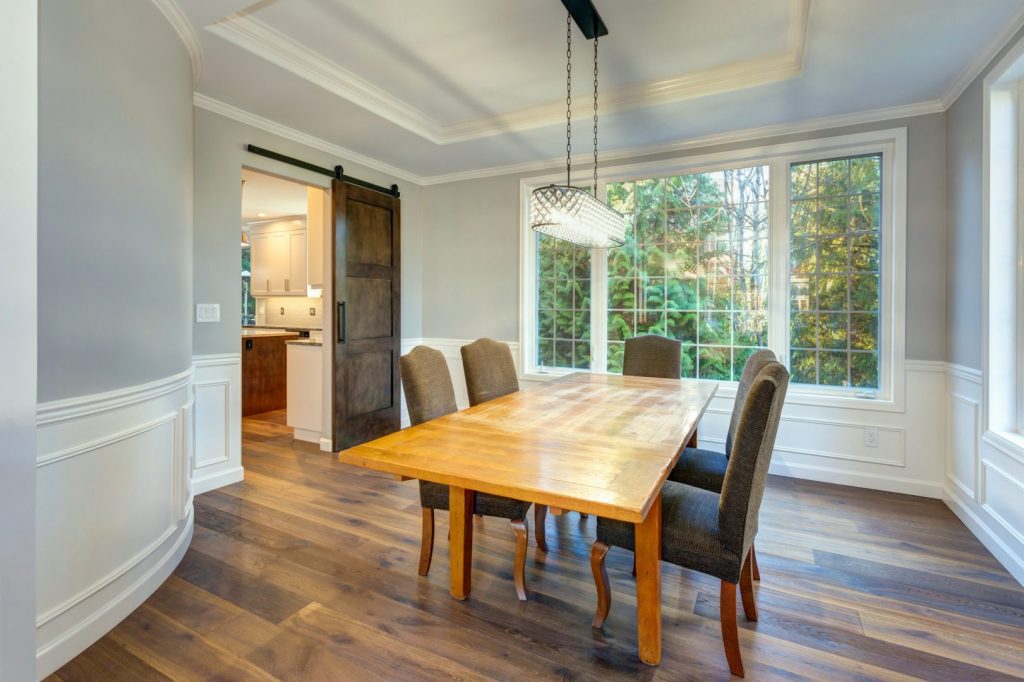
Accessible, universal design dining room with plenty of passage space around the table, a hard surface floor, controls at a comfortable height, and an easy-to-operate sliding barn door
There is a strong desire by many people to remain living in their current homes, and especially people in what we would deem the senior adult category – those age 55 and over. This trend for aging in place is undeniable. Either recently or years ago, people have found the home they want to remain living in because it suits their needs well enough for that to be their forever home, to the exclusion of any other type of home that they might want to consider. Having lived in several previous homes, on average, they are deciding that their present home offers them what they need and meets their needs as well or better than any previous home they have lived in or any they could search for and find.
While aging in place generally is thought to be just about seniors, all of us are part of it.
Thus, people are deciding to remain in their current homes for the rest of their lives for a variety of reasons beginning with the fact that they like their homes. It could be because of the layout, general features, size, the yard, or its location – it offers great access to shopping and major transportation routes, it provides great neighbors, it has a prestigious address, it is in a classic neighborhood, or it provides a great view. It might remind them of a home they lived in as a child, or it may just fulfill what they have been looking for in a home. On average, people are remaining in their present homes much longer than at any other recent time, and this is irrespective of age.
Other reasons that people love their current homes and are not interested in leaving them include the financial perspective – the costs associated with moving if that were to happen (buying a new place, paying for the move itself, selling their present home, the taxes and assessments on the new home, higher association dues, and maintenance). Also, their current home may be difficult to replace it in a desirable location for all that it represents to them and at a price commensurate with their current investment.
People may treasure the memories of all that has gone on in the home while raising their family – whether that family is still living at home or are living on their own. This also could be the ideal spot for them to bring either their grown children or their aging parents (or both) back under one roof to provide a larger sense of family and the care that they need.
All of that said, the current home – as desirable as it is emotionally to create a sense of staying put and not moving – may not be totally right for everyone’s needs. This is where improvements and modifications can help, and a universal design approach may make the most sense.
Universal design satisfies the needs of many people – those living in the home already and any guests or visitors that might join them. Sometimes, specialized design treatments are necessary to accommodate molitly, sensory, or cognitive needs, but often universal design takes these various abilities into account and offers a design that works for nearly everyone. It creates equitable access to the home and the various parts of it (bedrooms, bathrooms, kitchen, laundry room, home office, living room, family room, breakfast area, garage, and more) by making sure that doorways, thresholds, light switches, lighting, flooring, shelving, cabinetry, windows, fixtures, and appliances are within the normal reach of residents of the space plus their visitors. They are easy to use and operate also.
It is the great equalizer because it literally accommodates all heights, sizes, ages, and physical abilities in the home except the very young and those with very special needs that don’t respond well to a general design. However, even most mobility assistance is accommodated within universal design.
There are many ways to include universal design renovations and treatments into a solution or improvement project, depending on the client’s budget, time frame available to complete the modifications, and current features present in the home (including construction parameters present), but they definitely are worth pursuing.
Aging in place solutions can be provided specifically for the client, on a case-by-case basis, or we can create more of a universal design delivery where we provide the support and assistance that the client desires and requires but in such a way that the design fits into the home environment without calling attention to itself as something special that has been done. It should only be noticeable as something attractive or interesting that maybe wasn’t there previously.
